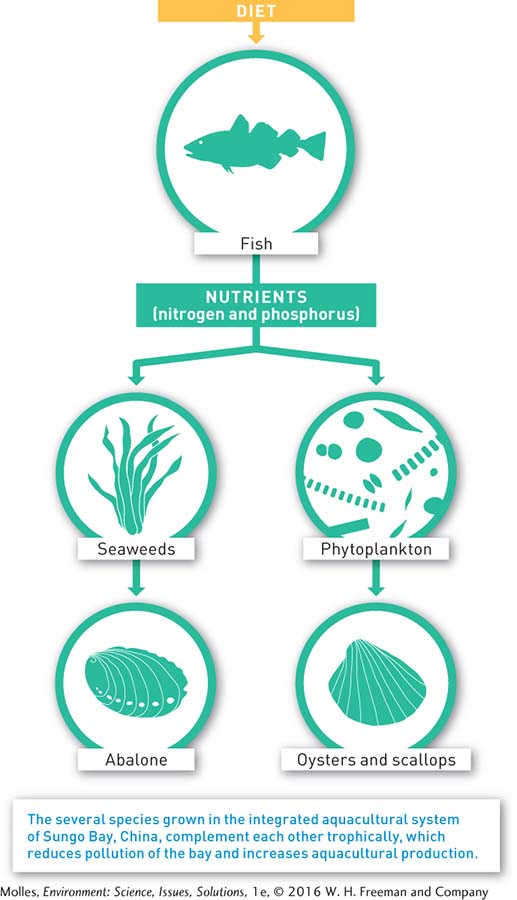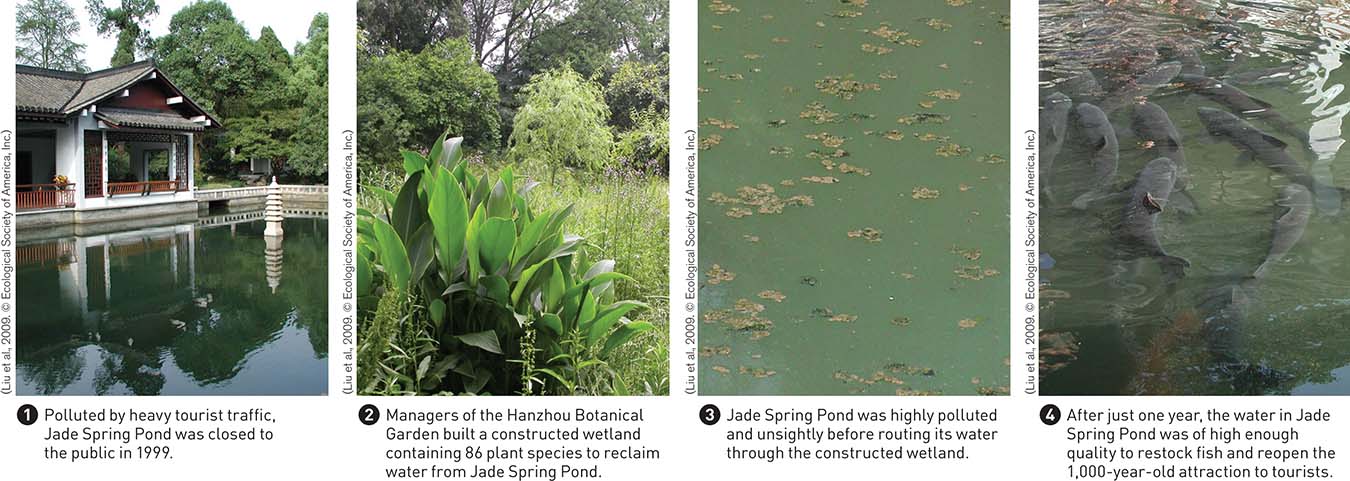8.10 Aquaculture can provide high-
As the world recognizes the limits of the oceans, many hope that aquaculture can take some pressure off wild populations. However, as aquaculture continues to expand, one of the challenges is making it more efficient and environmentally friendly.
Reducing Pollution by Aquaculture
integrated multi-
One of the most effective ways to reduce pollution from aquaculture is through integrated multi-

255

How might IMTA increase profits and reduce costs in an aquaculture system?
Integrated multi-
Aquaculture Wastes and Constructed Wetlands
Biological approaches are also being used to make land-
constructed wetlands Artificial wetland ecosystems, used in the treatment of wastewater, that are constructed in areas where wetlands may not occur naturally.
Increasingly, constructed wetlands, which are artificial wetland ecosystems constructed in areas where wetlands do not occur naturally, can be used to treat wastewater from freshwater aquaculture (Figure 8.37). Constructed wetlands foster the complex biological functions of nutrient removal by plants and microbes, and they can also provide habitat for wildlife. While they can be effective and self-

Shrimp Farming and Mangrove Conservation
There are several ways to reduce the impact of shrimp farming on mangrove forests. One problem is containment of the nutrient-
Recognizing this danger, many shrimp ponds are now sited behind protective mangrove forests, and the necessary ocean water is delivered to the inland ponds through a canal or pipeline. Finally, because ponds dedicated to intensive shrimp culture need to be completely drained periodically, they are increasingly built above the high-
Reducing the Impact of Sea Lice
One of the most direct approaches to reducing the impact of sea lice on wild salmon is to monitor and treat lice infestations on captive salmon using pesticides. However, there are concerns that sea lice will evolve resistance to such treatments and that nontarget organisms will be killed—
256
Decreasing the Use of Fish Meal
Reducing the impact of aquaculture on wild forage fish populations hinges on finding substitutes for fish meal and fish oil. Much progress has been made in replacing fish meal with plant protein (e.g., soy). Fish oils have also been partially replaced by plant oils, including canola, soy, sunflower, or olive oil. Fish nutrition experts predict that three-
Think About It
257
How are integrated aquaculture systems converging on the structure of natural food webs (see Chapter 2, page 40)?
How can knowledge of the influence of biodiversity on ecosystem processes help reduce the environmental impact of aquaculture?
What are the potential contributions of using plant-
based feeds to aquaculture sustainability?
8.7–8.10 Solutions: Summary
One key to properly managing fisheries is a management plan built on sound science. In the case of whales, an international ban helped species recover. Fisheries are generally regulated through gear restrictions and limits to the amount of time and the period when a fishing vessel can be at sea. Competitive approaches to fishing can be avoided by granting fishing quotas to individuals, cooperatives, or communities. Fishing quotas also appear to encourage more cooperation between fishers and fisheries scientists and managers, and marine protected areas improve fisheries while simultaneously increasing marine biodiversity.
Thousands of projects around the world, large and small, are aimed at restoring rivers and wetlands, and this increasingly involves dam removal. Aquaculture now accounts for nearly 40% of total fisheries production. With the massive increase in aquacultural production comes the potential for massive environmental damage. One of the most effective ways to reduce pollution from aquaculture is through integrated multi-